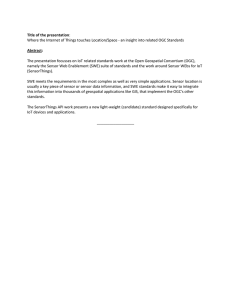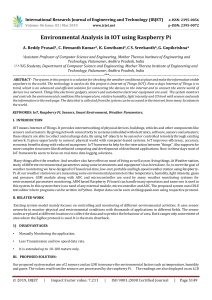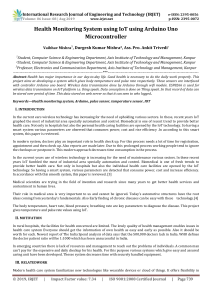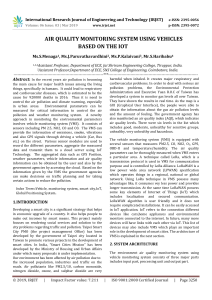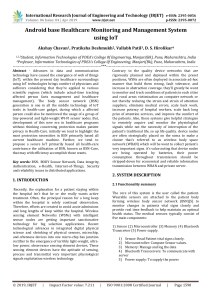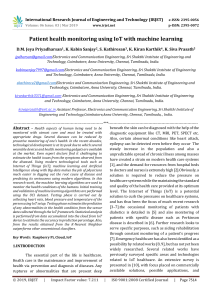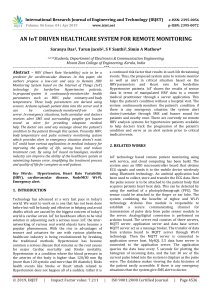IRJET-Talking Plant using IoT and Machine Learning
advertisement
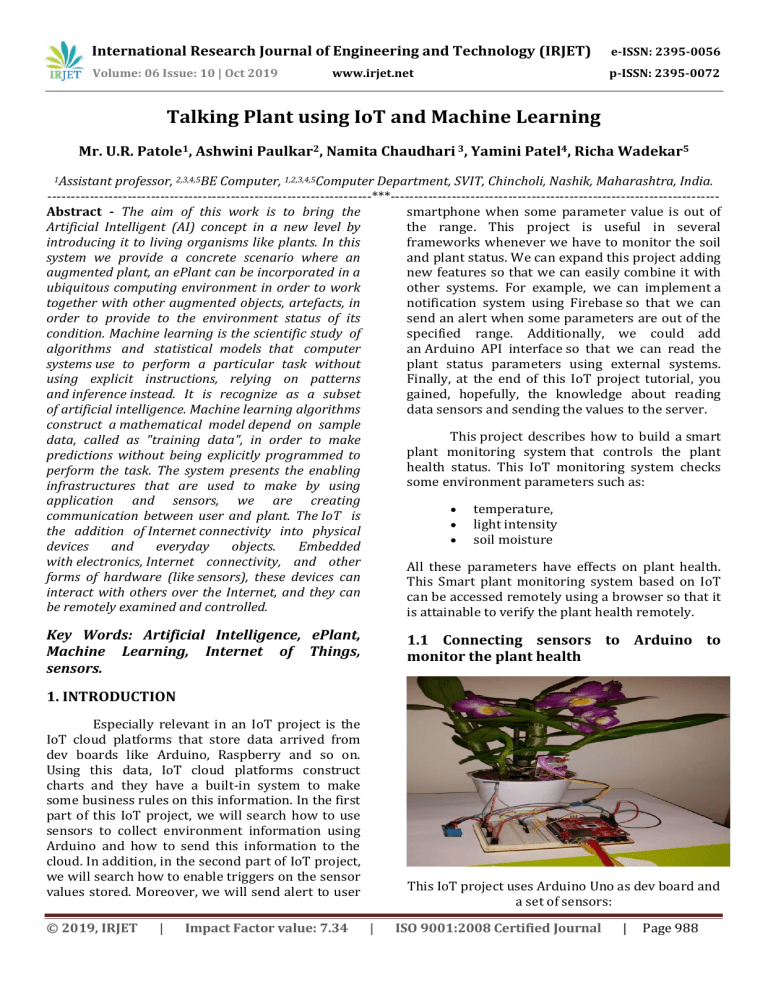
International Research Journal of Engineering and Technology (IRJET)
e-ISSN: 2395-0056
Volume: 06 Issue: 10 | Oct 2019
p-ISSN: 2395-0072
www.irjet.net
Talking Plant using IoT and Machine Learning
Mr. U.R. Patole1, Ashwini Paulkar2, Namita Chaudhari 3, Yamini Patel4, Richa Wadekar5
1Assistant
professor, 2,3,4,5BE Computer, 1,2,3,4,5Computer Department, SVIT, Chincholi, Nashik, Maharashtra, India.
---------------------------------------------------------------------***---------------------------------------------------------------------Abstract - The aim of this work is to bring the
smartphone when some parameter value is out of
Artificial Intelligent (AI) concept in a new level by
the range. This project is useful in several
introducing it to living organisms like plants. In this
frameworks whenever we have to monitor the soil
system we provide a concrete scenario where an
and plant status. We can expand this project adding
augmented plant, an ePlant can be incorporated in a
new features so that we can easily combine it with
ubiquitous computing environment in order to work
other systems. For example, we can implement a
together with other augmented objects, artefacts, in
notification system using Firebase so that we can
order to provide to the environment status of its
send an alert when some parameters are out of the
condition. Machine learning is the scientific study of
specified range. Additionally, we could add
algorithms and statistical models that computer
an Arduino API interface so that we can read the
systems use to perform a particular task without
plant status parameters using external systems.
using explicit instructions, relying on patterns
Finally, at the end of this IoT project tutorial, you
and inference instead. It is recognize as a subset
gained, hopefully, the knowledge about reading
of artificial intelligence. Machine learning algorithms
data sensors and sending the values to the server.
construct a mathematical model depend on sample
This project describes how to build a smart
data, called as "training data", in order to make
plant
monitoring
system that controls the plant
predictions without being explicitly programmed to
health
status.
This
IoT monitoring system checks
perform the task. The system presents the enabling
some environment parameters such as:
infrastructures that are used to make by using
application and sensors, we are creating
temperature,
communication between user and plant. The IoT is
light intensity
the addition of Internet connectivity into physical
soil moisture
devices
and
everyday
objects.
Embedded
with electronics, Internet connectivity, and other
All these parameters have effects on plant health.
forms of hardware (like sensors), these devices can
This Smart plant monitoring system based on IoT
interact with others over the Internet, and they can
can be accessed remotely using a browser so that it
be remotely examined and controlled.
is attainable to verify the plant health remotely.
Key Words: Artificial Intelligence, ePlant,
Machine Learning, Internet of Things,
sensors.
1.1 Connecting sensors to Arduino to
monitor the plant health
1. INTRODUCTION
Especially relevant in an IoT project is the
IoT cloud platforms that store data arrived from
dev boards like Arduino, Raspberry and so on.
Using this data, IoT cloud platforms construct
charts and they have a built-in system to make
some business rules on this information. In the first
part of this IoT project, we will search how to use
sensors to collect environment information using
Arduino and how to send this information to the
cloud. In addition, in the second part of IoT project,
we will search how to enable triggers on the sensor
values stored. Moreover, we will send alert to user
© 2019, IRJET
|
Impact Factor value: 7.34
This IoT project uses Arduino Uno as dev board and
a set of sensors:
|
ISO 9001:2008 Certified Journal
|
Page 988
International Research Journal of Engineering and Technology (IRJET)
e-ISSN: 2395-0056
Volume: 06 Issue: 10 | Oct 2019
p-ISSN: 2395-0072
www.irjet.net
DHT11
YL-69: Soil moisture sensor
YL-38 + YL-69
TEMT6000
YL-69 is a sensor to calculate the soil moisture. It
has to be inserted into the plant soil.
TEMT6000: Light intensity
DHT11: Temperature humidity sensor
TEMT6000 is a sensor to calculate the light
intensity so that we can know how light the plant is
receiving.
DHT11 is a sensor to calculate temperature and
pressure. It is a cheap sensor and suitable for
Arduino, you can use a more perfect sensor but the
way to use it is the same.
2. LITERATURE SURVEY
Sr. No.
Title
Author
Year
Published
Limitation
1
Fuzzy logic based
moisture control in
sinter plant
Ahmet
Beşkardeş
2018
26th Signal Processing
and Communications
Applications
Conference (SIU)
Complex
2
Temperature
control
experimental plant
for moisture model
assessment in
power transformers
Wilver
Correa
2017
IEEE 3rd Colombian
Conference on
Automatic Control
(CCAC)
Its only
concentrated on
moisture level
3
IoT enabled plant
soil moisture
monitoring using
wireless sensor
networks
A.M.
Ezhilazhahi
2017
Third International
Conference on Sensing,
Signal Processing and
Security (ICSSS)
WNS difficult to
understand
4
Impact of Different
Substrate Moisture
Levels on Lettuce
Plants during
Ground Based
Experiment in
SVET-2 Space
Greenhouse
Iliana Ilieva
2007
3rd International
Conference on Recent
Advances in Space
Technologies
It just a concept
© 2019, IRJET
|
Impact Factor value: 7.34
|
ISO 9001:2008 Certified Journal
|
Page 989
International Research Journal of Engineering and Technology (IRJET)
e-ISSN: 2395-0056
Volume: 06 Issue: 10 | Oct 2019
p-ISSN: 2395-0072
www.irjet.net
3. SYSTEM ARCHITECTURE
Fig. 1 : Talking Plant using IoT and AI
System Description:
4. MATHEMATICAL MODEL
S = (I,O,F)
Where,
S: System.
I = { S1,M, T, WL} are set of Inputs
Where,
1. S1: Sunlight
2. M: Moisture
3. T : Temparature
4. WL: Water Level
F = {F1, F2, F3, F4}are set of Function
Where,
1. F1: Moisture calculation
© 2019, IRJET
|
Impact Factor value: 7.34
|
ISO 9001:2008 Certified Journal
|
Page 990
International Research Journal of Engineering and Technology (IRJET)
e-ISSN: 2395-0056
Volume: 06 Issue: 10 | Oct 2019
p-ISSN: 2395-0072
www.irjet.net
2. F2: Ckeck Sunlight
BIOGRAPHIES
3. F3: Water Level calculation
4. F4: Check Temparature
Name:Uttam R. Patole
{ O1 } are set of Output
Educational Details:
Where,
M. Tech (CSE)
1. O1: Communication with Plant/Plants
Requirement
Success Conditions :
Sensor embedding, Location details,
proper database.
Name:Ashwini H. Paulkar
Failure Conditions:
Educational Details:
B.E. Computer (Pursuing)
No database, internet connection
5. CONCLUSION
Our system is making a drastic change in
technology which is transforming the living things
who can’t express their needs to make them
express. Hence our is system is making the new
way of communication in which user will directly
asked plant what they need, we are overcoming the
drawback of existing system.
Name:Namita A. Chaudhari
Educational Details:
B.E. Computer (Pursuing)
REFERENCES
1] IST Advisory Group. (2003, September).
Ambient Intelligence: from vision to reality.
Available:a. http://www.cordis.lu/ist/istagreports.htm
Name:Yamini A. Patel
Educational Details:
2] PLANTS Consortium:PLANTS roadmap,
PLANTS IST-2001-38900 Technical Report,
April 2004
B.E. Computer (Pursuing)
3] e-Gadgets
project
website:
http://www.extrovertgadgets.net
4] Kameas A., et al.: An Architecture that
Treats Everyday Objects as Communicating
Tangible Components. In Proceedings of the
1st IEEE International Conference on
Pervasive Computing and Communications
(PerCom03), Fort Worth, a. USA, 2003.
Name:Richa R. Wadekar
Educational Details:
B.E. Computer (Pursuing)
5] Drossos, N., Goumopoulos, C. and Kameas,
A., A Conceptual Model and the Supporting
Middleware.
© 2019, IRJET
|
Impact Factor value: 7.34
|
ISO 9001:2008 Certified Journal
|
Page 991


